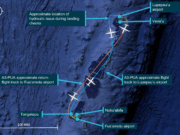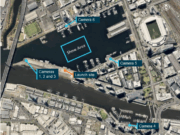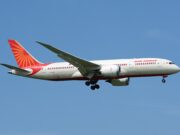
The following information provides an awareness of problems that might be avoided in the future. The information is based on final reports by official investigative authorities on aircraft accidents and incidents.
 Jets
Jets
Visibility Below Minimums
Boeing 737-400. Substantial damage. No injuries.
Before departing from Karachi, Pakistan, for a scheduled flight to Lahore the morning of Nov. 3, 2015, the flight crew learned that visibility at the destination was 1,500 m, which was below the 1,600 m (1 mi) required for the only approach available to them: a VOR/DME (VHF omnidirectional radio/distance measuring equipment) approach to Runway 36L. The instrument landing system (ILS) approach was undergoing maintenance, and the aircraft was not equipped to conduct the area navigation (RNAV) approaches available at Lahore.
The report by the Safety Investigation Board of Pakistan (SIB) said that the crew should have delayed the departure until visibility improved. However, the flight departed as scheduled. As the 737 neared Lahore, the crew learned that visibility had decreased to 1,200 m (3/4 mi). Although this should have prompted a diversion to an alternate airport, the crew decided to continue to Lahore, the report said.
The captain told the first officer (FO) to request vectors for the ILS approach to Runway 36R. “According to the FO, they were planning to follow the ILS procedure, break off after acquiring visual [contact] with the runway and land on Runway 36L,” the report said. “This was a nonstandard procedure.” Air traffic control (ATC) rejected the request and cleared the crew to conduct the VOR/DME approach instead.
Cockpit voice recorder data indicated that the captain was unable to concentrate on the arrival and approach, the report said. He had difficulty in identifying pertinent information on the charts and entered the wrong arrival procedure in the flight management system. The error was corrected by the FO, who “was continuously found to be prompting the captain for decision making,” the report said.
A Lahore Approach controller noticed that the aircraft frequently was off course and 2,000 to 2,500 ft too high while conducting the arrival procedure. The captain told the FO to extend the flaps but rejected his advice to also use the speed brakes to help descend to the proper altitude.
The captain disengaged the autopilot and, against the FO’s advice, hand-flew the nonprecision approach. The aircraft remained too high, and recorded flight data showed large variations in airspeed, heading and bank angle during the approach, which should have prompted a go-around, the report said. The captain asked the FO several times if he had the runway in sight. The FO replied that he did not. He kept advising the captain to turn right, presumably to place the aircraft on the proper approach course.
As the aircraft neared the minimum descent altitude, the FO saw the runway off to the right. He briefly assumed control of the 737 and turned toward the runway. The captain resumed control when he, too, caught sight of the runway but was unable to correctly align the aircraft. The FO advised that the aircraft was drifting to the right, and the captain told him to “relax.” The 737 was about 100 ft above the ground when the FO assumed control again. The captain replied “OK” but kept his hands on the flight controls.
The 737 was in a 4.5-degree right crab when the right main landing gear contacted the runway. The aircraft bounced and touched down again on the left main gear, which began to shimmy and then collapsed. The aircraft then veered off the left side of the runway onto soft ground, where the right main gear collapsed. The 737 was substantially damaged, but none of the 121 people aboard was injured.
A mandatory medical evaluation of the captain after the accident revealed high levels of alcohol and lactic acid in his blood. The report said that the former likely had impaired his decision-making during the flight and that the latter likely had induced fatigue that further impaired his performance. The net result, according to the SIB, was that the captain had been “unable to cope with the difficult situation.”
Gust Lock Remains Locked
Embraer Phenom 505. Minor damage. No injuries.
The pilot recalled removing the rudder gust lock pin while preparing for a personal flight from Palm Springs, California, U.S., the morning of Nov. 23, 2014. “He stated that the taxi out for takeoff was normal but that he detected an abnormal ‘feel’ to the rudders,” said the report by the U.S. National Transportation Safety Board (NTSB). “He added that all of the turns to the runway were right turns and that he ‘easily executed’ the turns.”
Shortly after liftoff, however, the pilot had to use left aileron input to counter a substantial right yaw and roll. “He also attempted to apply left yaw trim, but neither action resolved the issue,” the report said. The pilot returned to the airport and conducted a visual approach. The left wingtip was damaged when it struck the runway as the pilot attempted to correct a right drift on rollout, but none of the five occupants was hurt.
“The initial examination of the airplane revealed that the rudder gust lock had failed in the locked position,” the report said. “The gust lock actuator had likely begun to retract as commanded by the pilot … during the preflight checks. However, the solenoid located within the gust lock actuator failed, which resulted in the pin no longer being held in the retracted position.” Investigators were unable to determine conclusively why the gust lock actuator solenoid failed.
Overheated Inverter Emits Smoke
Airbus A320-214. Minor damage. No injuries.
The A320 was climbing to cruise altitude during a flight from Edinburgh, Scotland, to Hamburg, Germany, the afternoon of Nov. 28, 2016, when the flight crew detected smoke and fumes in the cockpit. They donned their oxygen masks, declared an emergency and were cleared to divert to Newcastle, England.
“During the descent, the smoke appeared to dissipate after the crew carried out the quick reference handbook (QRH) avionics smoke drill,” said the report by the U.K. Aircraft Accidents Investigation Branch. The crew landed the aircraft without further event at Newcastle. None of the 172 passengers and six crewmembers was injured.
Investigators found that the smoke and fumes had been generated by an overheated static inverter capacitor in a cockpit electrical system, a problem that had occurred in other A320s. The report said that the operator of the incident aircraft was not aware that Airbus had identified the cause of the problem and had issued a service bulletin in October 2016 recommending replacement of more than 2,000 static inverters in the A320 fleet.
Workers Toppled by Jet Blast
Boeing 737-800. No damage. Two minor injuries.
The flight crew shut down the right engine and started the auxiliary power unit while taxiing the 737 to the stand after landing at Dublin (Ireland) Airport the afternoon of Nov. 2, 2015. The crew stopped the aircraft next to a work site to await the arrival of marshallers. When they arrived, the crew increased thrust from the left engine and began a right turn toward their assigned stand, said the report by the Irish Air Accident Investigation Unit.
As left engine fan speed reached 55 percent, creating jet blast in excess of 50 mph (80 kph), the aircraft had been turned directly away from the work site, where work was being halted for the day. Two workers who were securing a perimeter fence were blown backward into the work site by the jet blast. “Both workers were taken by ambulance to a nearby hospital, where examination revealed that neither had suffered any fractures, although both had sustained bruising,” the report said.
 Turboprops
Turboprops
‘Not Adequately Prepared’
Cessna 441. Destroyed. Two fatalities.
The pilot’s preflight weather briefing included advisories for low ceilings and visibilities along the route from Lakeland, Florida, U.S., to Cairo, Georgia, the morning of Nov. 9, 2015. “The airplane was 33 miles [61 km] from its destination in cruise flight at 3,300 ft and above a solid cloud layer when the pilot declared to [ATC] that he had the destination airport ‘in sight’ and cancelled his instrument flight rules (IFR) clearance,” the NTSB report said.
Recorded radar data showed that the 441’s subsequent flight track was “erratic” and took the airplane away from the airport, the report said. The pilot then re-established radio communication with ATC; he reported that he had lost visual contact with the airport and requested clearance for an instrument approach. “The controller then provided a sequence of heading and altitude assignments to vector the airplane onto [an RNAV] approach, but the pilot did not maintain these assignments,” the report said. “The controller provided several corrections, [but] the airplane’s flight track indicated that the pilot was not adequately prepared to execute the controller’s instructions.”
The airplane ultimately entered a descending right turn, struck trees and burned. The pilot and his passenger were killed. NTSB concluded that the pilot had lost control of the airplane due to spatial disorientation. “Also causal to the accident was the pilot’s impairment by the combined effects of multiple medications and drugs,” the report said. Toxicological tests of tissue samples from the pilot revealed the presence of ethanol, amphetamine, an opioid painkiller, two sedating antihistamines and marijuana.
Split Flaps on Final
Cessna 208B. Minor damage. No injuries.
The pilot was cleared by ATC to conduct an RNAV approach to Townsville Airport in Queensland, Australia, the afternoon of Nov. 10, 2015. He acquired visual contact with the airport at about 1,000 ft above sea level and selected the third stage of flaps (30 degrees extension) in preparation for landing.
“However, this selection of flap resulted in a ‘muffled bang’ from outside the aircraft, which the pilot described as sounding like a tyre blowout,” said the report by the Australian Transport Safety Bureau (ATSB). “The pilot also reported that the aircraft banked ‘violently’ and steeply to the left.”
The Caravan continued to roll left despite the pilot’s application of right aileron. He then applied right rudder. “There was some response from the aircraft to this control input, but the pilot reported it was still not ‘under control,’” the report said. The pilot regained partial control after retracting the flaps from 30 degrees to 20 degrees of extension, which resulted in a reduction in the angle of bank. He then landed the aircraft without further incident. None of the eight passengers nor the pilot was injured.
The pilot fully retracted the flaps while taxiing to the parking area. Initial examination of the aircraft by the pilot and a maintenance engineer revealed no anomalies. “However, when the engineer gave the left flap a shake, it fell freely down, unattached to the inboard side,” the report said. “After removing some wing access panels, the engineering inspection discovered a loose flap bell crank retaining bolt.”
Detachment of the bell crank likely allowed the left flap to be raised by the airstream to nearly zero extension while the right flap remained extended 30 degrees, causing asymmetric lift and the partial loss of control. Investigators were unable to determine conclusively why the retaining bolt loosened.
‘Too Low for a Missed Approach’
Beech King Air 200. Substantial damage. Three minor injuries.
The King Air was on a single-pilot charter flight with six passengers the night of Nov. 23, 2016. The reported visibility at the destination — Moorhead, Minnesota, U.S. — was 1/4 mi (400 m) above the minimum required for the global positioning system lateral navigation approach, and the ceiling was at the minimum descent altitude (MDA). The pilot told ATC that he would conduct one approach to Moorhead and, if unable to land, he would divert to his alternate, the NTSB report said.
The pilot told investigators that shortly after leveling off at the MDA, he saw the runway end identifier lights and the precision approach path indicator. He disengaged the autopilot and was in the process of turning on the landing lights when the runway became obscured by clouds.
“The pilot immediately decided to conduct a missed approach and applied engine power,” the report said. “However, it is likely that the airplane got too low for a missed approach, which resulted in controlled flight into terrain.” The front-seat passenger and the pilot, who were not wearing their shoulder harnesses, suffered minor facial injuries, another passenger also sustained minor injuries, and the other four passengers escaped injury when the King Air struck terrain short of the runway in a nose-up, level attitude, the report said.
 Piston Airplanes
Piston Airplanes
Break-Up in ‘Extreme Weather’
Cessna 421C. Destroyed. One fatality.
The pilot was conducting a business flight from Houston, Texas, U.S., to Tulsa, Oklahoma, the night of Nov. 26, 2012. The airplane was cruising at 23,000 ft when ATC advised the pilot of an area of thunderstorms and moderate to extreme turbulence about 40 nm (74 km) ahead. The controller confirmed that the 421 was equipped with weather radar and cleared the pilot to deviate from course as necessary.
The NTSB report said that the airplane continued on a steady heading until it encountered a severe thunderstorm “that likely contained hail up to 1.25 inches [3.18 cm] in diameter.” The 421 turned 90 degrees right and then entered “an erratic steep descent that continued to the end of the [radar] data.” The horizontal stabilizers and the outboard wing sections separated from the airplane during the descent. “Witnesses near the accident site [in Wells, Texas] reported hearing an explosion and then seeing a fireball descending through the clouds to the ground,” the report said.
NTSB concluded that the probable cause of the accident was “the pilot’s decision to continue the flight into an area of extreme weather.”
Oil Filter Comes Loose
Cessna 310. Substantial damage. Two fatalities.
The 310’s right engine had undergone extensive maintenance, and the pilot and his pilot-rated passenger planned to conduct several circuits of the traffic pattern at Monett (Missouri, U.S.) Regional Airport before repositioning the airplane to a nearby private airport on Nov. 4, 2012. “However, the flight was delayed to make an adjustment of the propeller friction lock,” the NTSB report said. “Because of the delay, the pilots departed after the sun had set and decided to fly directly to the other airport,” rather than to conduct the post-maintenance test flight first.
The airplane was nearing the private airport in Miller, Missouri, at about 800 ft when oil pressure in the right engine decreased, followed by a loss of power. The pilot shut down the engine, feathered the propeller and decided to return to Monett. However, he was unable to maintain altitude and attempted to land on a highway. The aircraft struck trees on approach and was consumed by fire after striking the ground in Stotts City, Missouri.
“Post-accident examination of the right engine revealed that the oil filter adapter was not properly assembled or adequately secured to the engine,” the report said. “The mechanic who performed maintenance to the oil adapter admitted that he did not follow the manufacturer’s instructions when reassembling the adapter and when installing it on the engine. As a result, the adapter came loose during flight, which resulted in a loss of oil.”
The report noted that the manufacturer’s performance specifications for the airplane indicated that it should have been able to achieve a single-engine climb rate of 166 fpm “with the landing gear extended, assuming the airplane was properly configured and the operating engine was producing full power.” NTSB concluded that “the pilot’s failure to maintain airplane control after he shut down the right engine in flight” was the probable cause of the accident and that “the mechanic’s improper assembly and installation of the right engine’s oil filter adapter” was a contributing factor.
 Helicopters
Helicopters
Tail Rotor Driveshaft Fails
Bell 206B. Substantial damage. Two minor injuries.
The pilot and his passenger were conducting an aerial inspection of a farm in Bathurst, New South Wales, Australia, the morning of Nov. 21, 2016. The JetRanger was in a turn about 75 ft above ground level when they heard a bang and felt a vibration. As the pilot reduced airspeed to land the helicopter, it began to rapidly yaw right.
Application of left anti-torque pedal had no effect, but the pilot was able to arrest the yaw by reducing power, the ATSB report said. He attempted to cushion the touchdown by pulling back on the cyclic, but the helicopter landed hard and was substantially damaged. Both occupants sustained minor damage.
Examination of the JetRanger revealed that the tail rotor driveshaft had fractured at the no. 2 bearing, but investigators were unable to determine the cause of the failure.
Towel Ingested by Fenestron
Airbus EC135-P2. Substantial damage. No injuries.
Five people were aboard the helicopter for a fire-fighting training mission at Apple Valley, California, U.S., the morning of Nov. 19, 2015. The helicopter was about to touch down during the third landing when the pilot felt it shudder. “The pilot immediately landed and shut down the helicopter without further incident,” the NTSB report said.
Investigators found that a towel from an unsecured storage container at the landing site had been ingested by the helicopter’s fenestron, causing damage to the tail rotor blades, housing body, tail boom and driveshaft flex couplings.
Winds Suspected in Performance Loss
Robinson R44. Substantial damage. One minor injury.
The outside air temperature was 38 degrees C (100 degrees F), and variable, gusting winds prevailed when the pilot took off from a dirt road in Riversleigh Station, Queensland, Australia, the afternoon of Nov. 12, 2016, to return three passengers to Adels Grove. The R44 was about 100 ft above the ground when its climb performance began to deteriorate. “The helicopter started to descend, and the pilot advised there was insufficient engine power to prevent the descent,” the ATSB report said.
The right skid touched down on the road, and the left skid touched down off the side of the road, causing the helicopter to roll onto its left side. One passenger sustained minor injuries in the accident.
The helicopter was near its maximum takeoff weight, and density altitude at the landing site was about 3,400 ft. ATSB concluded that the loss of climb performance likely was caused by “a shift in wind direction to the right side side of the helicopter or [by] a decrease in head wind strength.”
“In the first scenario, a shift in wind direction to the right would demand more left tail rotor pedal to maintain takeoff heading and decrease the power available from the engine for main rotor thrust,” the report said. “In the second scenario, a decrease in wind strength just after translational lift would place the helicopter inside the HOGE [hover out of ground effect] flight regime and at the limit for the takeoff AUW [all-up weight] and temperature.”
| Date | Location | Aircraft Type | Aircraft Damage | Injuries |
|---|---|---|---|---|
|
NA = not available This information, gathered from various government and media sources, is subject to change as the investigations of the accidents and incidents are completed. |
||||
| Sept. 1 | Broomfield, Colorado, U.S. | Cessna 310G | substantial | 2 none |
| The landing gear collapsed on touchdown during an instructional flight. | ||||
| Sept. 1 | Lawrenceville, Georgia, U.S. | MD Helicopters 500 | substantial | 2 serious |
| Visual meteorological conditions (VMC) prevailed when the pilot lost control of the law-enforcement helicopter on approach. | ||||
| Sept. 2 | Chornoye, Russia | Antonov 2T | destroyed | 2 fatal |
| The An-2 crashed after the wings struck the runway in a steep turn during an airshow performance. | ||||
| Sept. 2 | Turinskaya Sloboda, Russia | Technoregion TR-301 | substantial | 1 NA |
| No fatalities were reported in the forced landing of the TR-301, a turbine and single-wing conversion of the Antonov 2. | ||||
| Sept. 2 | Tujunga, California, U.S. | Leonardo AW139 | substantial | 2 none |
| The helicopter struck trees while fighting a forest fire. | ||||
| Sept. 4 | Hato Viejo, Venezuela | British Aerospace 125-700A | destroyed | 2 fatal |
| The Hawker struck terrain under unknown circumstances. | ||||
| Sept. 4 | La Paragua, Venezuela | Antonov 2P | substantial | NA |
| No fatalities were reported when the An-2 flipped over while landing. | ||||
| Sept. 5 | San José, Costa Rica | Cessna U206 | destroyed | 2 fatal, 2 serious, 2 minor |
| The single-engine airplane struck terrain shortly after taking off on a commercial flight. | ||||
| Sept. 5 | Cochin, India | Boeing 737-800 | substantial | 108 none |
| No injuries were reported when the 737 turned off a taxiway after landing and struck a drainage ditch. | ||||
| Sept. 5 | Playa Linda, Venezuela | Antonov 2R | destroyed | 1 fatal |
| One passenger was killed when the An-2 crashed under unknown circumstances. | ||||
| Sept. 6 | Las Vegas | Boeing 757-200 | substantial | 184 none |
| The flight crew shut down the left engine on takeoff after receiving a fire warning, returned to the airport and conducted an overweight landing without further incident. | ||||
| Sept. 6 | Caenarfon, Wales | Piper Navajo | destroyed | 1 fatal |
| The Navajo struck terrain after the pilot lost control of the airplane on approach. | ||||
| Sept. 8 | Medford, New Jersey, U.S. | Schweizer 269C | substantial | 2 fatal |
| The pilot radioed that he could not control engine speed. He then shut down the engine and attempted an autorotative landing. Witnesses saw main rotor speed decrease substantially before the helicopter entered a steep descent and crashed short of the runway. | ||||
| Sept. 8 | Hertford, North Carolina, U.S. | Eurocopter MBB BK-117 | destroyed | 4 fatal |
| Witnesses saw heavy smoke trailing from the emergency medical services helicopter before it crashed in a wind turbine farm. | ||||
| Sept. 9 | Cerrione, Italy | Piper Seneca | destroyed | 1 fatal |
| The Seneca struck terrain on approach. | ||||
| Sept. 9 | McKinney, Texas, U.S. | Cessna 340 | substantial | 2 none |
| The left main landing gear collapsed on landing. Initial examination of the airplane revealed that the landing gear downlock was broken. | ||||
| Sept. 10 | Goma, Democratic Republic of the Congo | Antonov 26B | substantial | 4 none |
| The flight crew turned back to the airport after losing power from the right engine while departing on a cargo flight. The left main and nose landing gear collapsed when the An-26 overran the runway on landing. | ||||
| Sept. 11 | San Salvador de Paul, Venezuela | Britten-Norman Islander | none | 1 fatal |
| While landing, the airplane struck a child who was on the runway. | ||||
| Sept. 12 | Greeley, Colorado, U.S. | Embraer Brasilia | substantial | 27 none |
| The Brasilia was parked on the ramp when it was struck by a bus transporting the passengers. | ||||
| Sept. 13 | Nassau, Bahamas | Britten-Norman Islander | substantial | none |
| A fire erupted in a fuel tank while the Islander was undergoing routine maintenance in a hangar. | ||||
| Sept. 16 | Sedona, Arizona, U.S. | Cessna 208B | substantial | 9 none |
| A fly-in was in progress at the airport when the pilot landed. While he was following a truck to parking, the Caravan’s wing struck a light pole when he steered left of the taxiway centerline to avoid aircraft parked on the right side. | ||||
| Sept. 16 | Ancho, New Mexico, U.S. | Bell 206L-3 | destroyed | 1 fatal |
| VMC prevailed when the LongRanger struck terrain under unknown circumstances. | ||||
| Sept. 20 | Long Beach, California, U.S. | Robinson R22 | substantial | 1 serious |
| A student pilot was conducting takeoffs and landings when he felt the R22 shudder and heard the low-rotor-speed warning horn activate on approach. During the subsequent autorotative landing, the helicopter touched down hard and rolled over. | ||||
| Sept. 21 | Istanbul | Cessna Citation 7 | destroyed | 4 NA |
| The flight crew returned to the airport after experiencing a problem on takeoff. The Citation veered off the runway on landing and struck a concrete ditch. No fatalities were reported. | ||||
| Sept. 23 | Ainsworth, Nebraska, U.S. | Mitsubishi MU-2B-40 | destroyed | 1 fatal |
| Instrument meteorological conditions prevailed when the MU-2 struck terrain shortly after takeoff. | ||||
| Sept. 24 | Kuching, Malaysia | Beech King Air 250 | substantial | 6 NA |
| No fatalities were reported when the King Air veered off the runway while landing in heavy rain. | ||||
| Sept. 26 | Straz pod Ralskem, Czech Republic | Cessna 421B | NA | 2 fatal |
| The 421 crashed under unknown circumstances during a positioning flight. | ||||
| Sept. 26 | Norrbotten, Sweden | MD Helicopters 500 | NA | 1 fatal, 1 serious |
| The helicopter struck terrain shortly after takeoff. | ||||
| Sept. 26 | Dabajuro, Venezuela | Rockwell Aero Commander 500 | NA | 1 fatal, 1 serious, 1 none |
| The airplane struck two motorcyclists, killing one and injuring the other, during an emergency landing near the airport. The pilot was not hurt. | ||||
| Sept. 28 | Cape Town, South Africa | Robinson R44 | destroyed | 1 fatal |
| The R44 struck terrain during an attempted autorotative landing shortly after departure. | ||||
| Sept. 30 | Nsele, Democratic Republic of the Congo | Antonov 12B | destroyed | 8 fatal |
| The flight crew reported technical problems shortly after taking off from Kinshasa for a cargo flight. The An-12 struck terrain while returning to the airport. | ||||
| Sept. 30 | Goose Bay, Labrador | Airbus A380-861 | substantial | 521 none |
| The A380 was en route from Paris to Los Angeles when an uncontained failure of the no. 4 engine occurred over southern Greenland. The flight crew landed the airplane without further incident at Goose Bay. | ||||


